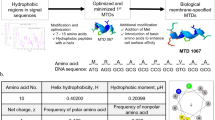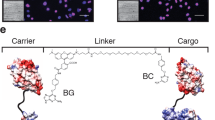Abstract
Efficient transdermal drug delivery of large hydrophilic drugs is challenging. Here we report that the short synthetic peptide, ACSSSPSKHCG, identified by in vivo phage display, facilitated efficient transdermal protein drug delivery through intact skin. Coadministration of the peptide and insulin to the abdominal skin of diabetic rats resulted in elevated systemic levels of insulin and suppressed serum glucose levels for at least 11 h. Significant systemic bioavailability of human growth hormone was also achieved when topically coadministered with the peptide. The transdermal-enhancing activity of the peptide was sequence specific and dose dependent, did not involve direct interaction with insulin and enabled penetration of insulin into hair follicles beyond a depth of 600 μm. Time-lapse studies suggested that the peptide creates a transient opening in the skin barrier to enable macromolecular drugs to reach systemic circulation.
This is a preview of subscription content, access via your institution
Access options
Subscribe to this journal
Receive 12 print issues and online access
$209.00 per year
only $17.42 per issue
Buy this article
- Purchase on Springer Link
- Instant access to full article PDF
Prices may be subject to local taxes which are calculated during checkout



Similar content being viewed by others
References
Prausnitz, M.R., Mitragotri, S. & Langer, R. Current status and future potential of transdermal drug delivery. Nat. Rev. Drug Discov. 3, 115–124 (2004).
Thomas, B.J. & Finnin, B.C. The transdermal revolution. Drug Discov. Today 9, 697–703 (2004).
Scheuplein, R.J. & Blank, I.H. Permeability of the skin. Physiol. Rev. 51, 702–747 (1971).
Williams, A.C. & Barry, B.W. Penetration enhancers. Adv. Drug Deliv. Rev. 56, 603–618 (2004).
Purdon, C.H., Azzi, C.G., Zhang, J., Smith, E.W. & Maibach, H.I. Penetration enhancement of transdermal delivery–current permutations and limitations. Crit. Rev. Ther. Drug Carrier Syst. 21, 97–132 (2004).
Kalia, Y.N., Naik, A., Garrison, J. & Guy, R.H. Iontophoretic drug delivery. Adv. Drug Deliv. Rev. 56, 619–658 (2004).
Lavon, I. & Kost, J. Ultrasound and transdermal drug delivery. Drug Discov. Today 9, 670–676 (2004).
Prausnitz, M.R. Microneedles for transdermal drug delivery. Adv. Drug Deliv. Rev. 56, 581–587 (2004).
Bos, J.D. & Meinardi, M.M. The 500 Dalton rule for the skin penetration of chemical compounds and drugs. Exp. Dermatol. 9, 165–169 (2000).
Karande, P., Jain, A. & Mitragotri, S. Discovery of transdermal penetration enhancers by high throughput screening. Nat. Biotechnol. 22, 192–197 (2004).
Karande, P., Jain, A., Ergun, K., Kispersky, V. & Mitragotri, S. Design principles of chemical penetration enhancers for transdermal drug delivery. Proc. Natl. Acad. Sci. USA 102, 4688–4693 (2005).
Cwirla, S.E., Peters, E.A., Barrett, R.W. & Dower, W.J. Peptides on phage: a vast library of peptides for identifying ligands. Proc. Natl. Acad. Sci. USA 87, 6378–6382 (1990).
Pasqualini, R. & Ruoslahti, E. Organ targeting in vivo using phage display peptide libraries. Nature 380, 364–366 (1996).
Arap, W., Pasqualini, R. & Ruoslahti, E. Cancer treatment by targeted drug delivery to tumor vasculature in a mouse model. Science 279, 377–380 (1998).
Raffii, S., Avecilla, S.D. & Jin, D.K. Tumor vasculature address book: identification of stage-specific tumor vessel zip codes by phage display. Cancer Cell 4, 331–333 (2003).
Frenkel, D. & Solomon, B. Filamentous phage as vector-mediated antibody delivery to the brain. Proc. Natl. Acad. Sci. USA 99, 5675–5679 (2002).
Duerr, D.M., White, S.J. & Schluesener, H.J. Identification of peptide sequences that induce the transport of phage across the gastrointestinal mucosal barrier. J. Virol. Methods 116, 177–180 (2004).
Guy, R.H. & Hadgraft, J . Transdermal Drug Delivery. (Marcel Dekker, New York, 2003).
Uversky, V.N. et al. Prediction of the Association State of Insulin Using Spectral Parameters. J. Pharm. Sci. 92, 847–858 (2003).
Montagna, W. The Structure and Function of Skin. (Academic Press, New York, 1956).
Grams, Y.Y. & Bouwstra, J.A. Penetration and distribution of three lipophilic probes in vitro in human skin focusing on the hair follicle. J. Control. Release 83, 253–262 (2002).
Rolland, A., Wagner, N., Chatelus, A., Shroot, B. & Schaefer, H. Site- specific drug delivery to pilosebaceous structures using polymeric microspheres. Pharm. Res. 10, 1738–1744 (1993).
Li, L. & Hoffman, R.M. The feasibility of targeted selective gene therapy of the hair follicle. Nat. Med. 1, 705–706 (1995).
Lauer, A.C., Lieb, L.M., Ramachandran, C., Flynn, G.L. & Weiner, N.D. Transfollicular drug delivery. Pharm. Res. 12, 179–186 (1995).
Agarwal, R., Katare, O.P. & Vyas, S.P. The pilosebaceous unit: a pivotal route for topical drug delivery. Methods Find. Exp. Clin. Pharmacol. 22, 129–133 (2000).
Meidan, V.M., Docker, M., Walmsley, A.D. & Irvin, W.J. Low intensity ultrasound as a probe to elucidate the relative follicular contribution to total transdermal absorption. Pharm. Res. 15, 85–92 (1998).
Joliot, A. & Prochiantz, A. Transduction peptides: from technology to physiology. Nat. Cell Biol. 6, 189–196 (2004).
Rothbard, J.B. et al. Conjugation of arginine oligomers to cyclosporin A facilitates topical delivery and inhibition of inflammation. Nat. Med. 6, 1253–1257 (2000).
Schutze-Redelmeier, M.-P.M., Kong, S., Bally, M.B. & Dutz, J.P. Antennapedia transduction sequence promotes anti tumour immunity to epicutaneously administered CTL epitopes. Vaccine 22, 1985–1991 (2004).
Lopes, L.B. et al. Comparative study of the skin penetration of protein transduction domains and a conjugated peptide. Pharm. Res. 22, 750–757 (2005).
Acknowledgements
We thank Yong Chen for help on sequence analysis. This work was supported by the One Hundred Talent Project and Nanomedicine Research Project (kjcx2-sw-h12-01) of the Chinese Academy of Sciences, Anhui Talent Fund (2004Z023) and National Natural Science Foundation of China (30470871).
Author information
Authors and Affiliations
Corresponding author
Ethics declarations
Competing interests
The authors declare no competing financial interests.
Supplementary information
Supplementary Fig. 1
Inhibition of transdermal activity of PH-1 by TD-1 (PDF 67 kb)
Supplementary Fig. 2
Insulin dose response (PDF 71 kb)
Supplementary Fig. 3
Assessment of direct interaction between TD-1 and insulin (PDF 32 kb)
Supplementary Fig. 4
Time course of hair follicle penetration of insulin-FITC (PDF 142 kb)
Supplementary Fig. 5
Hair follicle penetration of TD-1 (PDF 125 kb)
Supplementary Table 1
DLS measurement (PDF 18 kb)
Rights and permissions
About this article
Cite this article
Chen, Y., Shen, Y., Guo, X. et al. Transdermal protein delivery by a coadministered peptide identified via phage display. Nat Biotechnol 24, 455–460 (2006). https://doi.org/10.1038/nbt1193
Received:
Accepted:
Published:
Issue Date:
DOI: https://doi.org/10.1038/nbt1193
This article is cited by
-
Non-invasive transdermal delivery of biomacromolecules with fluorocarbon-modified chitosan for melanoma immunotherapy and viral vaccines
Nature Communications (2024)
-
Identification of efficient prokaryotic cell-penetrating peptides with applications in bacterial biotechnology
Communications Biology (2021)
-
A mussel-inspired film for adhesion to wet buccal tissue and efficient buccal drug delivery
Nature Communications (2021)
-
Progress in transdermal drug delivery systems for cancer therapy
Nano Research (2020)



